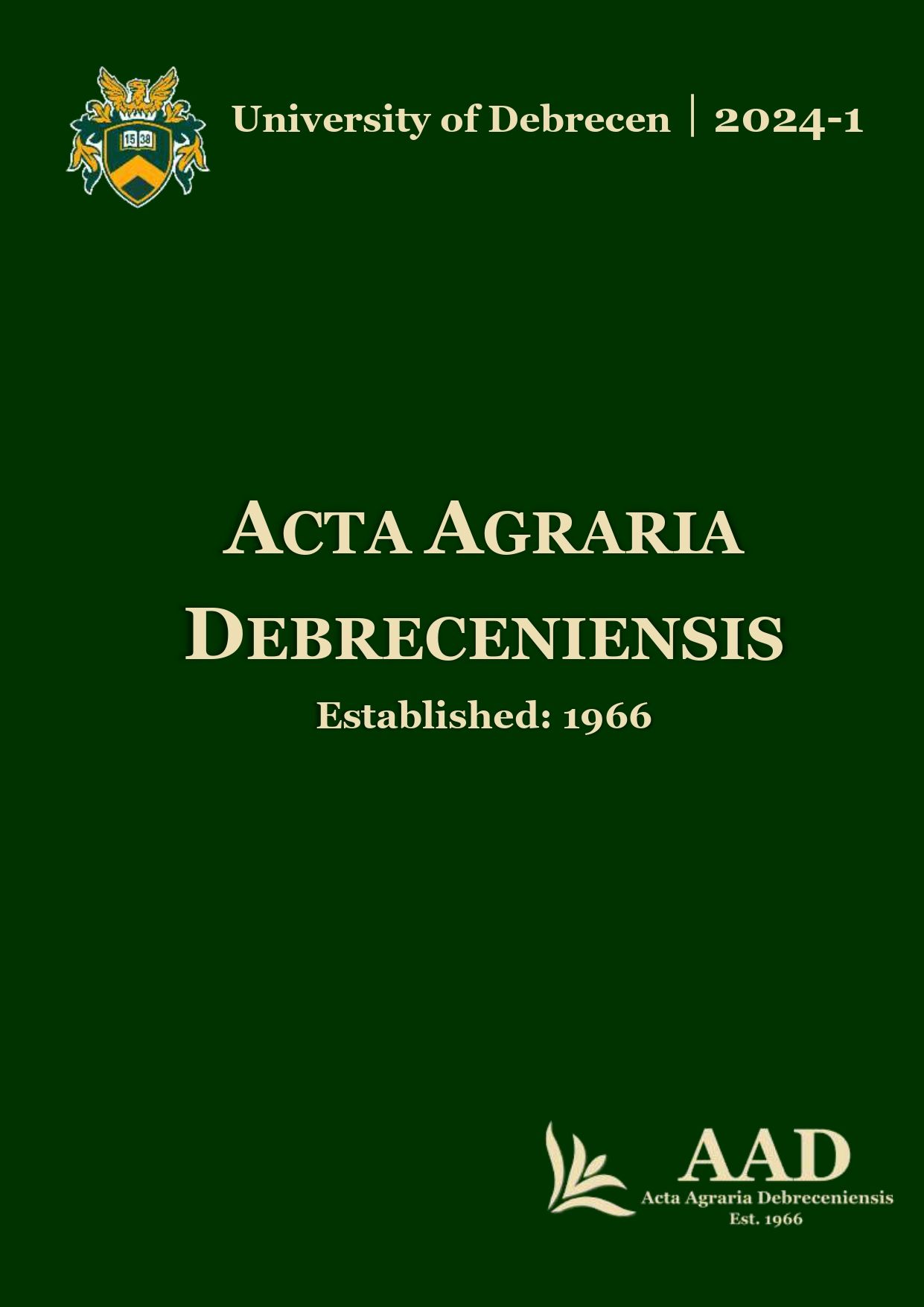The effect of washing for the shelf-life parameters of spinach (Spinacia oleracea L.)
Authors
View
Keywords
License
Copyright (c) 2024 by the Author(s)

This work is licensed under a Creative Commons Attribution 4.0 International License.
How To Cite
Accepted 2024-04-10
Published 2024-06-03
Abstract
Spinach is a very popular green leafy vegetable because of its versatile usage and beneficial for the health. However, spinach may contain several pathogen bacteria: Escherichia coli, Klebsiella spp., Salmonella spp., Enterobacter spp., Citrobacter spp., Shigella spp. and Listeria monocytogenes, which can cause several serious health problems. This study investigates the effects of washing with citric acid for the shelf-life parameters of spinach in comparison to the effect of washing with water and control. Washing of spinach with 0.5% citric acid solution decreased the elasticity of the spinach leaves, as well as the chlorophyll content. On the other hand, the total plate count, as well as the yeast and mold count could be decreased with this treatment, but difference was not detectable at the forth storage day. The fecal indicator E. coli did not change, indicating washing was not effective in this case. Further optimisation of treatment and storage conditions may decrease microbial risk of fresh spinach consumption without decreasing its sensory quality.
References
- /1998. (XI. 11.) EüM rendelet az élelmiszerekben előforduló mikrobiológiai szennyeződések megengedhető mértékéről.
- Abadias, M.; Usall, J.; Anguera, M.; Solsona, C.; Viñas, I. (2008): Microbiological quality of fresh, minimally-processed fruit and vegetables, and sprouts from retail establishments. Int. J. Food Microbiol., 123, 121–129. doi:10.1016/j.ijfoodmicro.2007.12.013.
- Al-Rousan, W.M.; Olaimat, A.N.; Osaili, T.M.; Al-Nabulsi, A.A.; Ayo, R.Y.; Holley, R.A. (2018): Use of acetic and citric acids to inhibit Escherichia coli O157:H7, Salmonella Typhimurium and Staphylococcus aureus in tabbouleh salad, Food Microbiology, 73, 61–66. https://doi.org/10.1016/j.fm.2018.01.001
- CDC (2023): Centers for Disease Control and Prevention: Lettuce, other leafy greens and food safety. 2023. https://www.cdc.gov/foodsafety/communication/leafy-greens.html (Accessed: December, 2023)
- Chazelas, E.; Deschasaux, M.; Srour, B.; Kesse-Guyot, E.; Julia, C.; Alles, B.; Druesne-Pecollo, N.; Galan, P.; Hercberg, S.; Latino-Martel, P.; Esseddik, Y.; Szabo, F.; Slamich, P.; Gigandet, S.; Touvier, M. (2020): Food additives: distribution and co-occurrence in 126,000 food products of the French market. Scientific Reports, 10, 3980. https://doi.org/10.1038/s41598-020-60948-w
- Cho, G.-L.; Ha, J-W. (2021): Synergistic effect of citric acid and xenon light for inactivating foodborne pathogens on spinach leaves. Food Res. International, 142, 110210. https://doi.org/10.1016/j.foodres.2021.110210.
- Cretescu, I.; Caprita, R.; Velicevici, G.; Camen, D.; Sirbu, C.; Buzamat, G.; Ropciuc, S. (2014): Researches regarding the influence of cold storage on the chlorophyll content in lettuce. Scientific Papers Animal Science and Biotechnologies, 47, 162–162.
- FAO (2023): https://www.fao.org/faostat/en/#data/QCL (Accessed: December, 2023)
- Finten, G.; Agüero, M. V.; Jagus, R. J. (2017): Citric acid as alternative to sodium hypochlorite for washing and disinfection of experimentally-infected spinach leaves, LWT- Food Science and Technology, 82, 318–325. http://dx.doi.org/10.1016/j.lwt.2017.04.047
- Frommer, D.; Veres, Sz.; Radocz, L. (2019): Changes of relative chlorophyll content in sweet corn leaves of different ages infected by corn smut, Agriculturae Conspectus Scientificus, 84 (2), 189–192.
- Jeon, M-J.; Ha, J-W. (2020): Synergistic bactericidal effect and mechanism of X-ray irradiation and citric acid combination against food-borne pathogens on spinach leaves. Food Microbiology, 91, 103543., https://doi.org/10.1016/j.fm.2020.103543.
- Li, X.S.; Xue, J.Z.; Qi, Y.; Muhammad, I.; Wang, H.; Li, X.Y.; Luo, Y.J.; Zhu, D.M.; Gao, Y.H.; Kong, L.C.; Ma, H.X. (2023): Citric Acid Confers Broad Antibiotic Tolerance through Alteration of Bacterial Metabolism and Oxidative Stress. International Journal of Molecular Sciences, 24, 9089. https://doi.org/10.3390/ijms24109089
- O’Neill, M.A.; York, W.S. (2001): The Plant Cell Wall (ed. J. K. C. Rose), Blackwell: Oxford. UK. pp. 1–54.
- Premkumar, L. (2014): Fascinating Facts about Phytonutrients in Spices and Healthy Food. United States of America. Xlibris: Bloomington, Indiana, United States.
- Roberts, J.L.; Moreau, R. (2016): Functional properties of spinach (Spinacia oleracea L.) phytochemicals and bioactives. Food and Function, 1–45.
- USDA (2023): https://www.ers.usda.gov/webdocs/publications/106016/err-315.pdf?v=8253.6 (Accessed: December, 2023)
- Yeni, F.; Yavas, S.; Alpas, H.; Soyer, Y. (2016): Most Common Foodborne Pathogens and Mycotoxins on Fresh Produce: A Review of Recent Outbreaks. Food Science and Nutrition, 56, 1532–1544.
- Yossa, N.; Patel, J.; Millner, P.; Lo, Y.M. (2012): Essential oils reduce Escherichia coli O157:H7 and Salmonella on spinach leaves. J Food Prot. 75, 488–96. doi: 10.4315/0362-028X.JFP-11-344.
- Zhou, B.; Luo, Y.; Nou, X;. Mwangi, E.; Poverenov, E.; Rodov, V.; Demokritou, P.; Fonseca, J. M. (2023): Effects of a novel combination of gallic acid, hydrogen peroxide and lactic acid on pathogen inactivation and shelf-life of baby spinach. Food Control, 143, 109284. https://doi.org/10.1016/j.foodcont.2022.109284.

 https://doi.org/10.34101/actaagrar/1/13575
https://doi.org/10.34101/actaagrar/1/13575